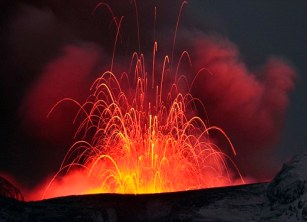Scientists are predicting that the world’s largest super-volcano in one of America’s most popular national parks could erupt in the near future.
Yellowstone National Park’s caldera has erupted three times in the last 2.1million years and researchers monitoring it say we could be in for another eruption.
They said that the super-volcano underneath the Wyoming park has been rising at a record rate since 2004 – its floor has gone up three inches per year for the last three years alone, the fastest rate since records began in 1923.
It would explode with a force a thousand times more powerful than the Mount St Helens eruption in 1980.
Spewing lava far into the sky, a cloud of plant-killing ash would fan out and dump a layer 10ft deep up to 1,000 miles away.
Two-thirds of the U.S. could become uninhabitable as toxic air sweeps through it, grounding thousands of flights and forcing millions to leave their homes.
But hampered by a lack of data they have stopped short of an all-out warning and they are unable to put a date on when the next disaster might take place.
When the eruption finally happens it will dwarf the effect of Iceland’s Eyjafjallajökull volcano, which erupted in April last year, causing travel chaos around the world.
The University of Utah’s Bob Smith, an expert in Yellowstone’s volcanism told National Geographic: ‘It’s an extraordinary uplift, because it covers such a large area and the rates are so high.
‘At the beginning we were concerned it could be leading up to an eruption.’
But he added: ‘Once we saw the magma was at a depth of ten kilometres, we weren’t so concerned.
‘If it had been at depths of two or three kilometre we’d have been a lot more concerned.’
Robert B. Smith, professor of geophysics at the University of Utah, who has led a recent study into the volcano, added: ‘Our best evidence is that the crustal magma chamber is filling with molten rock.
‘But we have no idea how long this process goes on before there either is an eruption or the inflow of molten rock stops and the caldera deflates again’.
The Yellowstone Caldera is one of nature’s most awesome creations and sits atop North America’s largest volcanic field.
Its name means ‘cooking pot’ or ‘cauldron’ and it is formed when land collapses following a volcanic explosion.
In Yellowstone, some 400 miles beneath the Earth’s surface is a magma ‘hotspot’ which rises to 30 miles underground before spreading out over an area of 300 miles across.
Atop this, but still beneath the surface, sits the slumbering volcano.
Scientists monitoring it believe that a swelling magma reservoir six miles underground may be causing the recent uplifts.
They have also been keeping an eye on a ‘pancake-shaped blob’ of molten rock he size of Los Angeles which was pressed into the volcano some time ago.
But due the extreme conditions it has been hard to work out what exactly is going on down below, leading researchers unable to say with certainty what will happen – or when.
Since the most recent blast 640,000 years ago there have been around 30 smaller eruptions, the most recent of which was 70,000 years ago.
They filled the caldera with ash and lava and made the flat landscape that draws thousands of tourists to Yellowstone National Park every year.
‘Clearly some deep source of magma feeds Yellowstone, and since Yellowstone has erupted in the recent geological past, we know that there is magma at shallower depths too,’ said Dan Dzurisin, a Yellowstone expert with the U.S. Geological Survey at Cascades Volcano Observatory in Washington State.
‘There has to be magma in the crust, or we wouldn’t have all the hydrothermal activity that we have.
‘There is so much heat coming out of Yellowstone right now that if it wasn’t being reheated by magma, the whole system would have gone stone cold since the time of the last eruption 70,000 years ago.’


